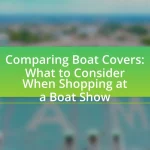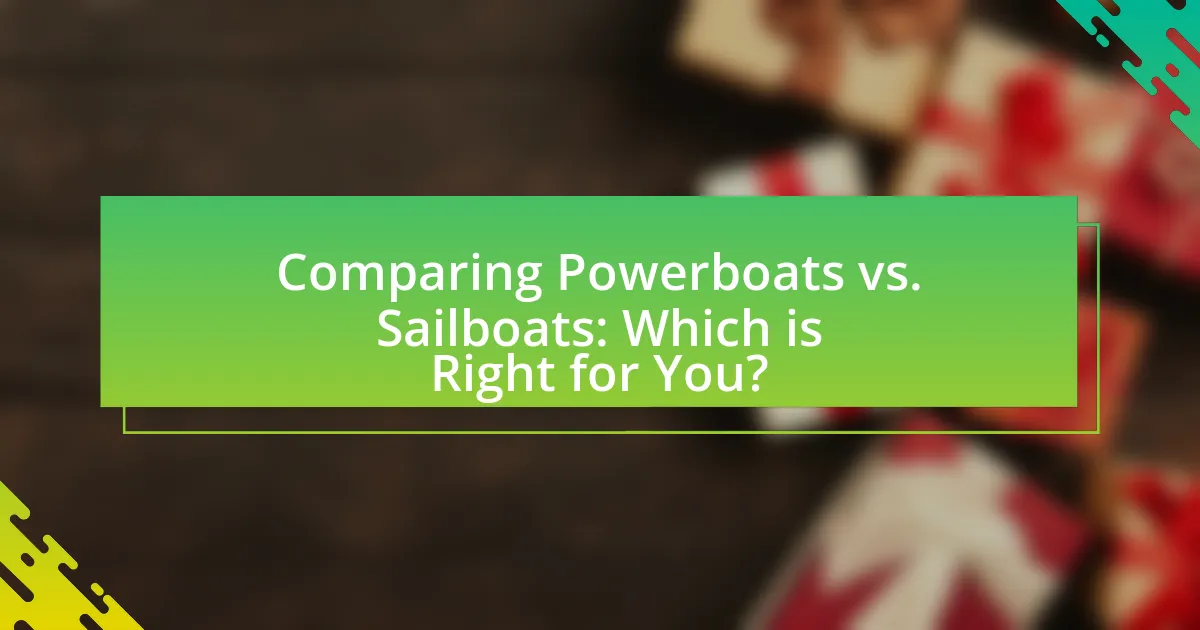Catamarans are multi-hulled watercraft known for their dual hull design, which offers enhanced stability, speed, and spaciousness compared to traditional monohulls. This article explores the differences between catamarans and monohulls, key design features, and the various types of catamarans available, including sailing and power models. It also discusses the benefits of owning a catamaran, such as improved comfort and safety, and provides insights into the best models for beginners, luxury options, and long-distance cruising. Additionally, the article covers essential considerations for selecting a catamaran, maintenance tips, and best practices for sailing, ensuring a comprehensive understanding of catamarans and their advantages in maritime activities.

What are Catamarans?
Catamarans are multi-hulled watercraft characterized by two parallel hulls of equal size. This design provides enhanced stability and speed compared to traditional single-hulled boats. Catamarans are commonly used for various purposes, including recreational sailing, fishing, and commercial transport, due to their spacious decks and efficient performance. The dual-hull structure allows for a larger living space and improved buoyancy, making them popular choices for both leisure and professional maritime activities.
How do Catamarans differ from Monohulls?
Catamarans differ from monohulls primarily in their hull design; catamarans have two parallel hulls, while monohulls have a single hull. This structural difference results in catamarans generally offering greater stability, reduced heeling, and increased space on deck and inside the vessel compared to monohulls. Additionally, catamarans often have shallower drafts, allowing them to navigate in shallower waters, which can be advantageous in certain sailing conditions.
What are the key design features of Catamarans?
Catamarans are characterized by their dual-hull design, which provides stability and reduces heeling compared to monohull boats. This design feature allows for a wider beam, enhancing deck space and improving comfort for passengers. Additionally, catamarans typically have a shallow draft, enabling access to shallower waters and making them suitable for various marine environments. The separation of the hulls also contributes to increased speed and efficiency, as they experience less drag. These features collectively make catamarans popular for both recreational sailing and commercial applications.
How does stability in Catamarans compare to Monohulls?
Catamarans are generally more stable than monohulls due to their wider beam and dual-hull design, which provides greater resistance to heeling. This stability is particularly evident in rough seas, where catamarans can maintain a more level position compared to monohulls that tend to tilt or heel significantly. Studies have shown that catamarans can experience less motion in waves, leading to a more comfortable ride for passengers. Additionally, the design of catamarans allows for a lower center of gravity, further enhancing their stability in various conditions.
What types of Catamarans are available?
There are several types of catamarans available, including sailing catamarans, power catamarans, and racing catamarans. Sailing catamarans are designed for leisure and cruising, featuring two hulls that provide stability and space. Power catamarans, on the other hand, are equipped with engines for faster travel and are often used for fishing or day cruising. Racing catamarans are built for speed and performance, typically used in competitive sailing events. Each type serves different purposes and caters to various preferences in the boating community.
What are the differences between sailing and power Catamarans?
Sailing catamarans rely on wind for propulsion, while power catamarans use engines. Sailing catamarans typically have sails and require knowledge of wind patterns and navigation, making them more dependent on weather conditions. In contrast, power catamarans offer greater speed and maneuverability, allowing for easier navigation in various conditions. Additionally, sailing catamarans often have a more eco-friendly profile due to their reliance on wind, whereas power catamarans may consume fuel and produce emissions. These fundamental differences influence their usage, maintenance, and overall sailing experience.
How do recreational and commercial Catamarans vary?
Recreational and commercial catamarans vary primarily in their design, purpose, and features. Recreational catamarans are typically designed for leisure activities, offering amenities such as comfortable seating, living spaces, and recreational equipment, while commercial catamarans are built for specific operational purposes like transportation, fishing, or tourism, often prioritizing durability and cargo capacity. For instance, commercial catamarans may include features like larger hulls for stability and increased load-bearing capabilities, which are essential for carrying passengers or goods efficiently. In contrast, recreational models focus on comfort and aesthetics, catering to the needs of leisure sailors.
What are the primary benefits of owning a Catamaran?
The primary benefits of owning a catamaran include stability, spaciousness, and fuel efficiency. Catamarans have two hulls, which provide greater stability on the water compared to monohulls, reducing the likelihood of capsizing and allowing for a smoother ride in rough conditions. Their design typically offers more living space, making them ideal for families or groups, as they often feature larger decks and cabins. Additionally, catamarans are generally more fuel-efficient due to their lighter weight and reduced drag, which can lead to lower operating costs over time. These advantages make catamarans a popular choice among sailors and recreational boaters.
How does a Catamaran enhance comfort and space on the water?
A catamaran enhances comfort and space on the water by providing a wider beam and dual-hull design, which results in increased stability and more usable deck space. The wider structure allows for larger living areas, including spacious cabins and open layouts, accommodating more amenities than monohull vessels. Additionally, the stability of catamarans reduces motion in rough waters, contributing to a more comfortable experience for passengers. This design feature is supported by the fact that catamarans typically have less heel and roll compared to traditional single-hull boats, making them preferable for families and those seeking a relaxed cruising experience.
What safety advantages do Catamarans offer?
Catamarans offer significant safety advantages due to their stability and buoyancy. The dual-hull design of catamarans provides a wider base, which reduces the likelihood of capsizing compared to monohull vessels. This stability is particularly beneficial in rough seas, as catamarans can better withstand waves and adverse weather conditions. Additionally, the design allows for a shallower draft, enabling catamarans to navigate in shallower waters safely. Furthermore, in the event of a hull breach, the remaining hull can still provide buoyancy, allowing for a higher chance of survival and easier recovery. These features collectively enhance the overall safety profile of catamarans, making them a preferred choice for many sailors.

What are the best Catamaran models available?
The best catamaran models available include the Lagoon 450, Fountaine Pajot Saona 47, and Leopard 45. The Lagoon 450 is renowned for its spacious interior and excellent sailing performance, making it a popular choice among cruising enthusiasts. The Fountaine Pajot Saona 47 offers a blend of luxury and functionality, featuring a large cockpit and modern amenities, which enhances the onboard experience. The Leopard 45 is celebrated for its robust construction and ease of handling, appealing to both novice and experienced sailors. These models are consistently highlighted in sailing reviews and industry rankings for their design, performance, and user satisfaction.
Which Catamarans are recommended for beginners?
The recommended catamarans for beginners include the Lagoon 380, the Fountaine Pajot Isla 40, and the Gemini Legacy 35. These models are favored for their stability, ease of handling, and spacious layouts, making them suitable for novice sailors. The Lagoon 380, for instance, is known for its user-friendly design and ample living space, which enhances comfort while learning to sail. The Fountaine Pajot Isla 40 offers a balance of performance and comfort, ideal for those new to catamaran sailing. The Gemini Legacy 35 is recognized for its manageable size and excellent maneuverability, making it a great choice for beginners.
What features should beginners look for in a Catamaran?
Beginners should look for stability, ease of handling, and adequate space when selecting a catamaran. Stability is crucial as catamarans have two hulls, which provide a wider base and reduce the likelihood of capsizing, making them safer for novice sailors. Ease of handling is important; features like a simple rigging system and user-friendly controls can significantly enhance the sailing experience for beginners. Adequate space is also essential, as catamarans typically offer more living and storage space compared to monohulls, which is beneficial for comfort during longer trips. These features collectively ensure a more enjoyable and manageable sailing experience for those new to catamarans.
How do beginner-friendly models compare in price and performance?
Beginner-friendly catamaran models typically range in price from $20,000 to $100,000, depending on size and features, while performance varies significantly based on design and intended use. For instance, models like the Lagoon 380 offer a balance of affordability and performance, providing stable sailing and spacious interiors, making them suitable for novice sailors. In contrast, higher-end models like the Fountaine Pajot Isla 40, priced around $400,000, deliver superior performance and advanced features but may be less accessible for beginners. This price-performance spectrum illustrates that while beginner-friendly models are generally more affordable, they may compromise on speed and advanced sailing capabilities compared to premium options.
What are the top luxury Catamarans on the market?
The top luxury catamarans on the market include the Lagoon 50, Fountaine Pajot Saona 47, and the Leopard 50. The Lagoon 50 is renowned for its spacious design and modern amenities, making it ideal for both leisure and long-term cruising. The Fountaine Pajot Saona 47 offers exceptional performance and comfort, featuring a stylish interior and ample outdoor space. The Leopard 50 is celebrated for its innovative layout and robust construction, providing a perfect blend of luxury and functionality. These models are recognized for their quality craftsmanship and advanced technology, ensuring a premium sailing experience.
What amenities do luxury Catamarans typically include?
Luxury catamarans typically include high-end amenities such as spacious living areas, fully equipped kitchens, multiple cabins with en-suite bathrooms, and outdoor lounging spaces. These vessels often feature advanced navigation systems, air conditioning, and entertainment systems, enhancing comfort and convenience for guests. Additionally, many luxury catamarans come with water sports equipment, such as kayaks and paddleboards, as well as Jacuzzis or swimming pools, providing a premium experience on the water.
How do luxury Catamarans perform in terms of speed and handling?
Luxury catamarans typically excel in both speed and handling due to their unique design, which features two parallel hulls that reduce drag and enhance stability. This design allows luxury catamarans to achieve higher speeds compared to monohull vessels, often reaching cruising speeds of 15 to 20 knots, with some models capable of exceeding 25 knots under optimal conditions.
In terms of handling, luxury catamarans offer superior maneuverability, particularly in tight spaces, thanks to their twin engines and balanced weight distribution. This results in easier docking and navigation in challenging conditions. Additionally, the stability provided by the dual hulls minimizes heeling, allowing for a more comfortable ride and better performance in rough seas.
These performance characteristics are supported by advancements in materials and technology, such as lightweight composites and efficient sail designs, which further enhance speed and handling capabilities.
What are the best Catamarans for long-distance cruising?
The best catamarans for long-distance cruising include the Lagoon 450, Fountaine Pajot Saona 47, and Leopard 45. The Lagoon 450 is renowned for its spacious interior and excellent stability, making it ideal for extended voyages. The Fountaine Pajot Saona 47 offers a balance of performance and comfort, featuring a large cockpit and efficient sailing capabilities. The Leopard 45 is praised for its robust construction and ease of handling, which is crucial for long journeys. These models are frequently recommended by experienced sailors and have received positive reviews for their reliability and performance in various sea conditions.
What features make a Catamaran suitable for long voyages?
Catamarans are suitable for long voyages due to their stability, spaciousness, and fuel efficiency. The twin-hull design of a catamaran provides enhanced stability on the water, reducing the likelihood of capsizing and allowing for a smoother ride in rough seas. Additionally, the ample living space and storage capacity in catamarans accommodate long-term cruising needs, making them comfortable for extended periods at sea. Their efficient hull shape allows for better fuel economy, enabling longer distances to be covered with less fuel consumption. These features collectively make catamarans an ideal choice for long-distance sailing.
How do different models handle various sea conditions?
Different catamaran models handle various sea conditions through design features and performance characteristics tailored to specific environments. For instance, models like the Lagoon 42 are designed with a wide beam and high freeboard, providing stability and comfort in rough seas, while the Fountaine Pajot Saona 47 features a more streamlined hull shape that enhances speed and maneuverability in choppy waters. Additionally, the use of lightweight materials in models such as the Outremer 45 allows for better performance in strong winds, as they can achieve higher speeds and maintain control. These design elements are supported by performance data, indicating that catamarans with wider beams and higher freeboards generally perform better in turbulent conditions, reducing the risk of capsizing and improving passenger comfort.

How can you choose the right Catamaran for your needs?
To choose the right catamaran for your needs, assess your intended use, budget, and desired features. For instance, if you plan to sail long distances, prioritize models with larger fuel and water capacities, while a catamaran for day sailing may require less space and amenities. Additionally, consider the number of passengers you expect to accommodate; models vary in size from small, personal vessels to larger ones designed for groups. Researching specific brands and models, such as Lagoon or Fountaine Pajot, can provide insights into performance and reliability, as these manufacturers are known for their quality and innovation in catamaran design.
What factors should you consider when selecting a Catamaran?
When selecting a catamaran, consider factors such as size, intended use, budget, and performance characteristics. The size of the catamaran affects its stability, space, and ease of handling; larger models provide more living space but may be harder to maneuver. Intended use, whether for cruising, racing, or chartering, influences design features and equipment. Budget constraints determine the range of options available, including new versus used models. Performance characteristics, including sail area, hull design, and weight, impact speed and handling in various conditions. These factors collectively guide the selection process to ensure the catamaran meets specific needs and preferences.
How does your intended use influence your choice of Catamaran?
Your intended use significantly influences your choice of catamaran by determining the design, size, and features that best meet your needs. For instance, if you plan to use the catamaran for long-distance cruising, you may prioritize models with larger fuel capacities, comfortable living spaces, and robust storage options. Conversely, if your intended use is for day sailing or racing, you might select a lighter, more agile catamaran designed for speed and maneuverability. Specific models, such as the Lagoon 42 for cruising or the Fountaine Pajot Isla 40 for performance, exemplify how different uses dictate design choices, ensuring that the catamaran aligns with the intended activities and enhances the overall experience on the water.
What budget considerations should you keep in mind?
When budgeting for a catamaran, consider the initial purchase price, which can range from $100,000 to over $1 million depending on size and brand. Additionally, account for ongoing costs such as maintenance, insurance, docking fees, and fuel, which can collectively amount to 10-20% of the boat’s value annually. For example, a $300,000 catamaran may incur $30,000 to $60,000 in yearly expenses. Furthermore, factor in financing options and potential depreciation, as catamarans typically lose value over time. Understanding these financial aspects is crucial for effective budgeting in catamaran ownership.
What are some common maintenance tips for Catamarans?
Common maintenance tips for catamarans include regularly inspecting and cleaning the hull, checking and maintaining the rigging, and ensuring the integrity of the sails. Regular hull inspections help identify any signs of wear or damage, while cleaning prevents marine growth that can affect performance. Rigging should be checked for fraying or corrosion, as this is crucial for safety and performance. Additionally, sails should be inspected for tears or UV damage, and proper storage can extend their lifespan. These practices are essential for maintaining the overall performance and safety of catamarans.
How can regular maintenance extend the life of your Catamaran?
Regular maintenance can significantly extend the life of your catamaran by preventing deterioration and addressing issues before they escalate. Routine tasks such as inspecting the hull for damage, checking the rigging, and maintaining the engine ensure that all components function optimally, reducing the risk of costly repairs. For instance, regular cleaning and antifouling of the hull can prevent marine growth, which can lead to structural damage and decreased performance. Additionally, maintaining the electrical systems and plumbing can prevent failures that might compromise safety and functionality. Studies show that vessels with consistent maintenance schedules can last up to 30% longer than those that are neglected, highlighting the importance of proactive care in preserving the integrity and longevity of a catamaran.
What are the most common issues Catamaran owners face?
Catamaran owners commonly face issues such as maintenance challenges, structural integrity concerns, and equipment failures. Maintenance challenges often arise from the need for regular upkeep of dual hulls, which can be more complex than monohulls. Structural integrity concerns may include issues with the hulls or crossbeams, particularly in older models, leading to potential safety risks. Equipment failures, such as problems with sails, engines, or electrical systems, can also occur, impacting the overall performance and safety of the vessel. These issues are well-documented in boating literature, highlighting the importance of regular inspections and maintenance to mitigate risks associated with catamaran ownership.
What are the best practices for sailing a Catamaran?
The best practices for sailing a catamaran include understanding its unique handling characteristics, maintaining proper weight distribution, and utilizing the sails effectively. Catamarans have a wider beam, which affects stability and maneuverability; therefore, sailors should adjust their sailing techniques accordingly. Proper weight distribution is crucial; placing heavier items low and centrally helps maintain balance and prevents capsizing. Additionally, effective sail trim is essential; ensuring sails are correctly adjusted for wind conditions maximizes performance and efficiency. These practices are supported by sailing experts who emphasize the importance of these techniques for safe and efficient catamaran sailing.
How can you improve your sailing skills on a Catamaran?
To improve your sailing skills on a Catamaran, practice regularly in varying wind and water conditions. Regular practice allows sailors to develop a better understanding of the vessel’s handling, responsiveness, and performance characteristics. Engaging in sailing courses specifically focused on Catamarans can also enhance skills, as these courses provide structured learning and expert guidance. Additionally, studying sailing techniques and strategies through books or online resources can further solidify knowledge and improve decision-making on the water.
What safety measures should you take while sailing a Catamaran?
While sailing a catamaran, essential safety measures include wearing life jackets, ensuring proper communication equipment is onboard, and conducting regular safety drills. Life jackets are crucial as they provide buoyancy and increase survival chances in emergencies. Communication equipment, such as VHF radios, allows for immediate contact with rescue services or other vessels. Regular safety drills familiarize the crew with emergency procedures, enhancing preparedness. Additionally, checking weather conditions before departure and maintaining a well-stocked first aid kit are vital for ensuring safety during the voyage.






